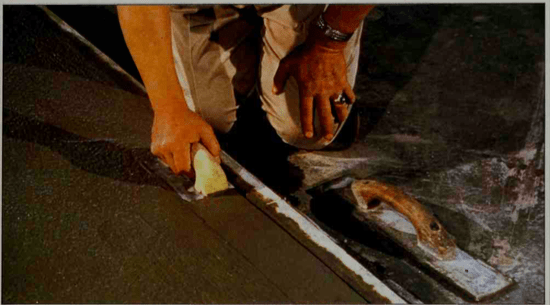Sidewalk Repair and Driveways Restoration
Constant ground shifting can cause cracks in driveways and sidewalks. A regular maintenance program is important to keep them in top shape.
Although asphalt driveways can withstand much of the abuse dealt them by the weather, they do tend to develop cracks and pits over time that need to be repaired to ensure a long life for the driveway.
A basic maintenance program for asphalt driveways involves the annual application of a blacktop sealer to protect the driveway against the sun, rain and snow. The waterproof sealer comes in premixed 19L (5gal) pails. The contents of one will cover from 20 to 40 sq m (200 to 400sq ft) depending on the thickness of application.
To apply, sweep the driveway clean of all debris and scrub oil spots with water and detergent Don’t use an oil solvent to clean off grease or oil, since it tends to soften the asphalt. Rinse the driveway thoroughly.
Pour some of the sealer onto the driveway and spread with a broom or roller. Make sure the driveway is wet for easier application. Use light strokes to help fill shallow pits and cracks but don’t apply too much sealer Wait until the sealer is dry to the touch before applying a second coat to cover any shallow pits or cracks missed in the first application. Try to ensure that the driveway is left untouched by traffic or rain fir at least 24 hours.
Larger cracks or pits should be filled before applying the sealer. To fill a hole or crack, apply a premixed asphalt-patching compound to within 25mm (1in) of the driveway surface. Tap it down firmly, then apply more compound to a level of about 12mm (1/2in) above the driveway surface Smooth the compound with a 2 x4 or by running your car over the patch a few times. Deep holes should be half-filled with coarse gravel before applying the compound. Once the patch is dry, you’re ready to apply the blacktop sealer.
Asphalt driveways are also subject to large-scale damage that most often results from improper construction.
Large-scale cracking, or alligatoring, can result from several poor construction techniques. In most instances, a professional will need to apply a hot-patch treatment to repair the damage
Large voids may also need professional work, since they could require a new layer of asphalt on the driveway.
Gravel driveways are subject to heaving, creating a washboard effect. If the heaving covers a large area, you’ll need to remove gravel and topsoil layers of the driveway until you’re down to the subsurface, which can be gravel, clay, rock or hard earth. Rent a compacter and compact the heaved areas, going over the driveway until the surface is level. Then regrade with topsoil and gravel, crowning the driveway in the center and sloping toward the sides. Then compact the surface again. Make sure the gravel you use has a large number of small fines in it for proper compaction.
Small heaved areas can be treated by simply adding more gravel to the hollow, compacting and repeating the procedure until the surface level is reached.
Sidewalk repairs
Like driveways, concrete sidewalks suffer from constant ground shifting. Cracks can appear in a concrete walkway, and pavers and flagstones can lift with the moving ground.
To repair a shifted slab, pry up one end of the concrete with a crowbar. Slip a round broomstick or pipe under the raised end to help you roll the slab out of the way. Tamp the ground even and fill any low spots with gravel. Add mortar dabs if mortar was used previously. Make sure the ground surface ;s tamped solidly and evenly, then replace the slab.
Repairing concrete is slightly more difficult than fixing a lifted paver but is certainly within the realm of the do-it-yourse’fer.
Concrete is composed of 1 part Portland cement, 2 parts sand and 3 parts fine gravel. However, you can buy premixed concrete that has either a latex, vinyl or epoxy base and dries quickly. These premixed concretes are best used for small concrete repairs, since they force you to work with haste.
If a large section of the sidewalk is cracked, it should be removed and replaced. Small cracks can be handled by patching.
To patch, use a cold chisel and hammer to undercut the crack, making the opening wider at the bottom than at the surface. Concrete will only grip the hole if it is undercut. Clean out all loose particles from the crack.
Wet the area inside and on the surface of the crack. If the area isn’t wet, the old concrete will draw the moisture out of the patch before the new concrete has a chance to set. Make sure the surface is damp but not running with water.
Trowel in the new concrete, tamp it firmly, then smooth the surface with a trowel so that it’s even with the surrounding area. Let the patch stiffen slightly, then lightly run a broom across the new concrete to provide a better gripping surface. Once the patch is stiff, keep it damp with plastic or wet burlap and let it cure for a week.
REPAIRING A SIDEWALK

If a large section of the sidewalk concrete; erect a form; pour your broom for grip; run an edging tool develops cracks, it’s best to replace concrete mixture; trowel it smooth; around the sides then let cure for that section. Chop out the old slightly roughen the surface with a several days.